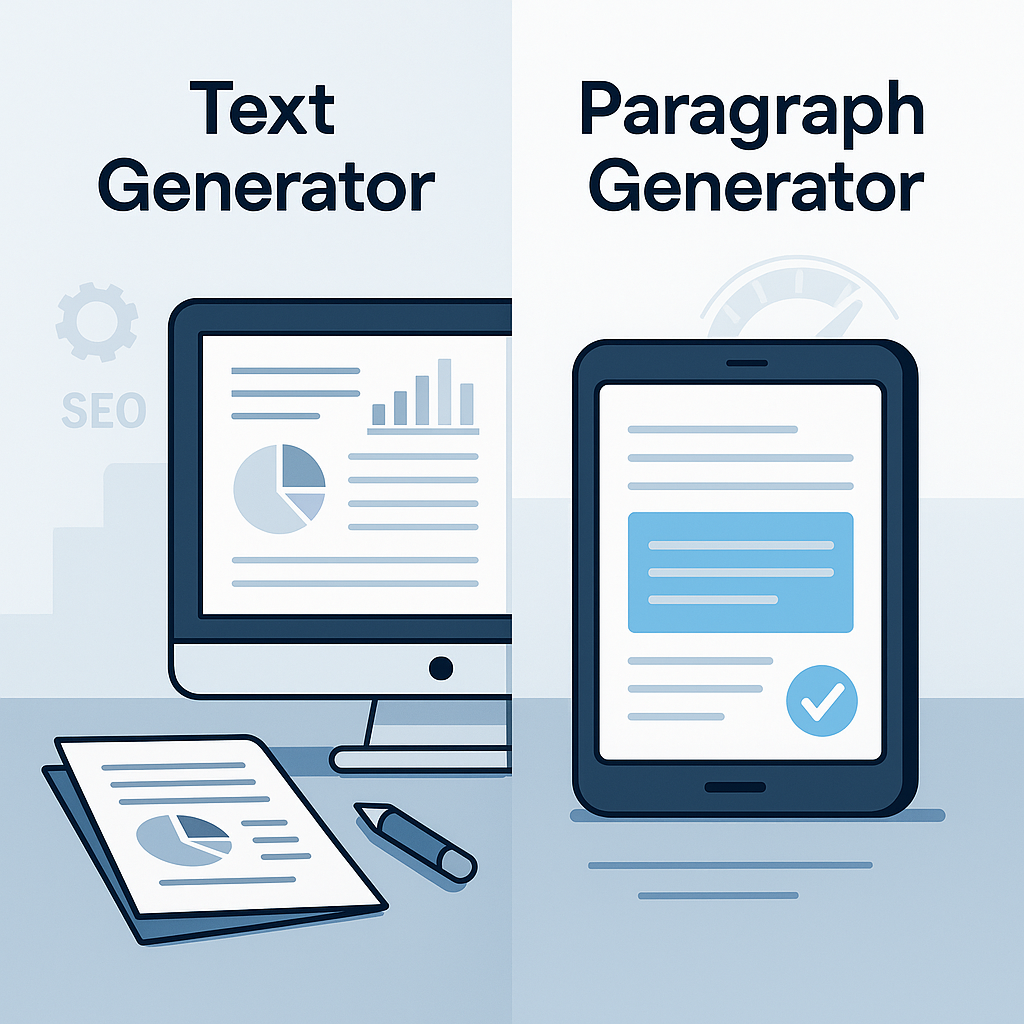Text Generator vs Paragraph Generator: Which Tool Wins?
%20(1).png)
You're under deadline. You need to finish a product description, polish a blog post, and write an email follow-up. You want to use an AI tool. But now comes the real question: Do you use a text generator or a paragraph generator?
AI writing assistants have exploded in capability and popularity, but not all are built for the same task. While text generators help you craft full-length articles, emails, and long-form content with detailed customization, paragraph generators focus on short-form output with lightning speed and minimal setup. So how do you decide?
In this guide, we’ll compare both tools across real-world use cases, strengths, and limitations. This article will help you pick the AI writing tool that fits your workflow, not the other way around.

Key Takeaways
- Text generators excel at long-form, structured, and brand-aligned content, while paragraph generators shine in speed and simplicity for short, standalone needs.
- Choosing the right tool depends on your use case — not just how advanced the AI is. Align tool choice with task complexity, collaboration needs, and content goals.
- Most effective content creators use both tools in tandem: text generators for depth and strategy, paragraph generators for agility and ideation.
Quick Comparison: Text Generator vs Paragraph Generator
No time to read the full breakdown? Here’s a fast, no-fluff comparison to help you choose the right AI tool in seconds:
Text Generator
- Best for long-form content, consistent tone, and brand-driven messaging
- Offers deeper control over structure, tone, and formatting
- Ideal when working on blog posts, emails, whitepapers, or multi-part campaigns
Paragraph Generator
- Best for quick wins: one-off paragraphs, summaries, or idea starters
- Super fast: minimal setup, instant results
- Ideal for content gaps, explanations, or social captions
Use Cases First: When to Use What
Before we dive into features and workflows, let’s focus on what matters most: how these tools fit into your real-world writing tasks. Here’s when each tool makes the most sense.
Text Generator — Ideal for...
Content Marketing Campaigns
Need to write blog posts, newsletters, product pages, and emails — all in a consistent voice? A text generator helps you build it all with narrative flow, SEO structure, and brand alignment.
SEO-Optimized Blog Posts
Use advanced tools like Creaitor's SERP Beater to generate long-form content with headings, internal links, and keyword optimization that performs in search engines.
Professional Communication
From pitch decks to investor updates, text generators offer control over tone, structure, and clarity — especially useful in B2B, legal, or technical writing.
Brand-Driven Messaging
Maintain brand consistency across multiple content types and channels. Text generators support tone control, reusable templates, and multi-format campaigns.
Paragraph Generator — Perfect when you...
Need a Single Paragraph
You’ve written most of your landing page, but one section still feels flat. A paragraph generator can instantly fill that gap — without overthinking it.
Want a Quick Explanation or Summary
Explaining a technical term? Summarizing a research finding? One prompt, one paragraph — done.
Need Ideas Mid-Draft
Hit a block while writing? Use a paragraph generator to spark a new direction or test alternative angles.
Write Social Media Snippets
Captions, callouts, or tweet-length content — paragraph generators let you produce short-form copy without setting up an entire campaign prompt.
Each tool has its place in your workflow. The key is knowing when to go deep and structured — and when you just need one solid paragraph to keep moving.
Deep Dive: What Text Generators Can Do
Text generators are full-scale AI writing systems designed for complex, structured, and high-volume content creation. Unlike paragraph generators that focus on short bursts of text, these tools handle entire documents — with control over tone, style, and structure.
How They Work
Text generators rely on large language models (LLMs) trained on massive datasets, including articles, marketing copy, technical documentation, and more. When you feed the tool a prompt, it uses that training to create content that’s context-aware, well-structured, and purpose-driven. More advanced platforms allow you to fine-tune output with tone guides, formatting logic, and even collaborative feedback.
Key Strengths
- Narrative flow: Generates long-form content that feels cohesive across sections and formats.
- Customization control: Adjust tone, voice, structure, and depth to fit the audience and channel.
- Content scaling: Write dozens of assets (like emails, blog posts, product pages) with consistent messaging.
- SEO alignment: Build keyword-rich content that meets technical SEO and readability standards.
Real-World Example
Imagine a small SaaS company preparing for a product launch. The marketing team uses a text generator to:
- Write a full blog post explaining the product’s value
- Generate onboarding emails tailored to new users
- Draft landing page sections optimized for search and conversion
- Repurpose the content for social, newsletter, and investor updates
What would normally take days across teams now gets outlined, drafted, and revised in a single afternoon — without compromising quality or consistency.
Deep Dive: What Paragraph Generators Are Best At
Paragraph generators do one thing — and they do it fast. These lightweight tools are built for short-form content creation: one paragraph at a time. Whether you’re filling a gap in a blog post, drafting a quick explanation, or brainstorming a caption, paragraph generators provide speed, simplicity, and immediate results.
How They Work
You enter a prompt — a question, a keyword, or even a rough idea — and the tool returns a coherent paragraph that matches the input. Most paragraph generators don’t require configuration or setup. The goal isn’t full-length content, but usable, editable building blocks.
Key Strengths
- Instant output: Get a paragraph in seconds with minimal input.
- Low learning curve: No need for templates, tone guides, or formatting — just type and go.
- Great for idea generation: Helpful for breaking through writer’s block or testing different angles.
- Perfect for short-form use cases: Think product blurbs, intros, social captions, or content transitions.
Real-World Example
A university student is working on a 3,000-word essay but struggling to write the conclusion. Instead of rewriting the entire argument, they enter their thesis statement and supporting points into a paragraph generator.
Within seconds, they get a paragraph that effectively summarizes the key insights — giving them a solid draft to polish, not a blank page to battle.
Which Tool Is Right for You? (Decision Guide)
Choosing between a text generator and a paragraph generator isn’t about which is “better”. It’s about which is right for your task, team, and timeline. Use the following decision paths to find the best fit for your current needs.
You need fast output with zero setup?
→ Go with a paragraph generator. It’s perfect for when you just need one solid paragraph to finish an article, create a quick summary, or test an idea. No templates, no tone calibration — just type and go.
You’re building multi-section content and care about tone consistency?
→ A text generator is your best bet. It lets you create longer content like blog posts, landing pages, or email campaigns with structure and brand voice intact.
You work in a team and need review workflows or collaboration?
→ Opt for a text generator that supports commenting, revision history, or user permissions. These platforms make it easier to align content across departments without version chaos.
You want to brainstorm short-form content or write in bursts?
→ A paragraph generator gives you low-effort, fast output. It’s ideal for testing messaging angles, drafting ad copy, or experimenting with social posts without spinning up a full document.
You want full control over structure, tone, and SEO?
→ Choose a text generator. It allows for prompt engineering, custom formatting, keyword integration, and long-form output designed for performance.
Frequently Asked Questions
What is the difference between a text generator and a paragraph generator?
A text generator creates long-form content such as blog posts, emails, or reports with full control over tone, structure, and formatting. A paragraph generator, on the other hand, produces short, standalone text blocks quickly and with minimal input — ideal for summaries, content gaps, or social media snippets.
Are text generators better for SEO content?
Yes. Text generators are better suited for SEO because they support structured formatting, keyword optimization, internal linking, and consistent tone across sections — making them ideal for writing blog posts and landing pages that perform in search engines.
Can I use both a text generator and a paragraph generator in the same project?
Absolutely. Many professionals combine both tools — using a text generator for structured content and overarching messaging, and a paragraph generator for quick fixes, content gaps, or alternative phrasing during the editing process.
Bottom Line
AI writing tools are essential companions for modern content creators. But not all tools serve the same purpose. Text generators give you depth, control, and scalability. Paragraph generators are built for speed and simplicity.
If you’re serious about content efficiency, you don’t have to choose one over the other. In fact, most professionals use both: one for structure and strategy, the other for iteration and inspiration.
Use the right tool for the right moment — and combine them when it counts. Ready to try both? Start with Creaitor and see how flexible AI content generation can be — whether you're building from scratch or just need the perfect paragraph.
Blog che potrebbero piacerti

Email Response Generator: Write Perfect Emails in Half the Time

AI Write Me a Cover Letter: Transform Your Job Applications with AI

